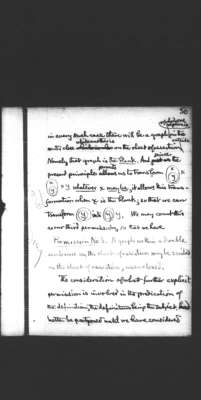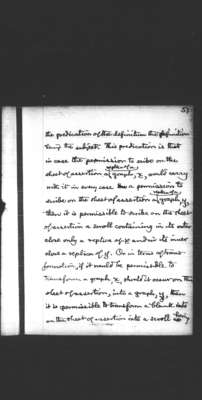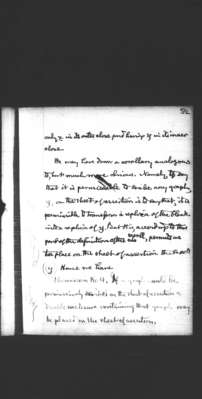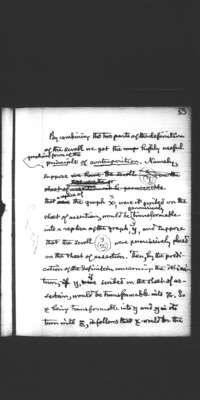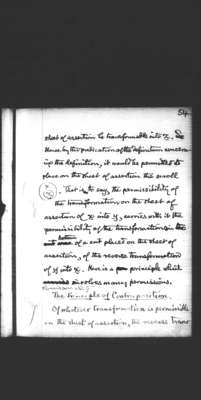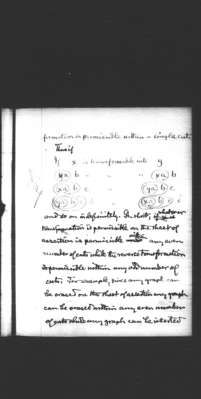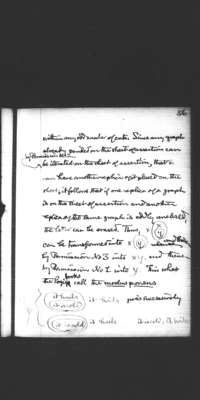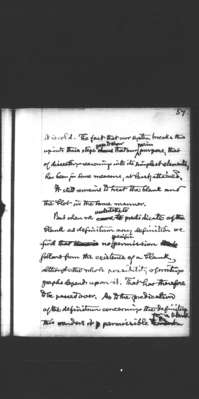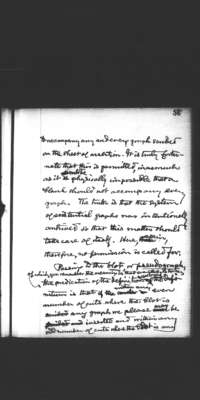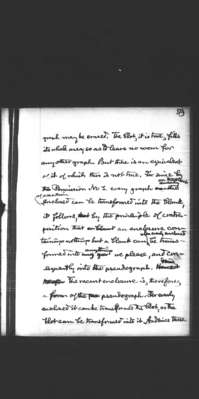Pages That Need Review
MS 455-456 (1903) - Lowell Lecture II
54
50
in every such case there will be a graph of which one replica is in the outer close which is also while another is on the sheet of assertion outside. Namely, that graph is the blank. And since the present principle allows permits us to transform [into] whatever x may be, it allows this transformation when x is the blank; so that we can transform into We may count this as our third permission, so that we have
Permission No 3. A graph within a double enclosure on the sheet of assertion may be scribed on the sheet of assertion, unenclosed.
The consideration of what further explicit permission is involved in the predication of the definition, the definitum being the subject, had better be postponed until we have considered
55
51
the predication of the definitum the definition being the subject. This predication is that in case the permission to scribe on the sheet of assertion a replica of a graph, x, would carry with it in every case a permission to scribe on the sheet of assertion a replica of a graph, y, then it is permissible to scribe on the sheet of assertion a scroll containing in its outer close only a replica of x and in its inner close a replica of y. Or in terms of transformation, if it would be permissible to transform a graph, x, should it occur on the sheet of assertion, into a graph, y, then it is permissible to transform a blank on the sheet of assertion into a scroll having
56
52
only x in its outer close and having y in its inner close.
We may here draw a corollary analogous to, but much more obvious. Namely, [To?] say that it is permissible to scribe any graph, y, on the sheet of assertion is to say that, it is permissible to transform a replica of the blank into a replica of y. But this, according to this part of the definition of the scroll, permits us to place on the sheet of assertion the scroll Hence we have
Permission No 4. If a graph could be permissively scribed on the sheet of assertion a double enclosure containing that graph may be placed on the sheet of assertion.
57
53
By combining the two parts of the definition of the scroll we get the highly useful graphical form of the principle of contraposition. Namely, suppose that a replica of the graph x, were it scribed on the sheet of assertion, would be permissively transformable into a replica of the graph, y, and suppose that the scroll were permissively placed on the sheet of assertion. Then, by the predication of the definition concerning the definitum, y, if scribed on the sheet of assertion, would be transformable into z. So x being transformable into y and y in its turn into z, it follows that x would [on?] the
58
54
sheet of assertion be transformable into z. Hence by the predication of the definitum concerning the definition, it would be permitted to place on the sheet of assertion the scroll That is to say, the permissibility of the transformation on the sheet of assertion of x into y, carries with it the permissibility of the transformation on the cut area bottom of a cut placed on the sheet of assertion, of the reverse transformation of y into x. Here is a principle which carries involves many permissions.
Permission No 5
The Principle of Contraposition.
Of whatever transformation is permissible on the sheet of assertion, the reverse transformation
59
is permissible within a single cut.
Thus if If x is transformable into y ... and so on indefinitely. In short, whatever transformation is permissible on the sheet of assertion is permissible within any even number of cuts while the reverse transformation is permissible within any odd number of cuts. For example, since any graph can be erased on the sheet of assertion any graph can be erased within any even number of cuts while any graph can be inserted
60
56
within any odd number of cuts. Since any graph already scribed on the sheet of assertion can by Permission No 2 be iterated on the sheet of assertion, that is can have another replica of it placed on the sheet, it follows that if one replica of a graph is on the sheet of assertion and another replica of the same graph is oddly enclosed, the latter can be erased. Thus, x can be transformed into x and thence by Permission No 3 into xy. and thence by Permission No 1 into y. [Thus?] what the logic books call the modus ponens it hails gives successively it hails it is cold . it hails
61
57
it is cold. The fact that our system breaks this up into three steps shows goes to show that our main purpose, that of dissecting reasoning into its simplest elements, has been , in some measure, at least, attained.
It still remains to treat the blank and the blot in the same manner.
But when we undertake to predicate of the blank as definitum any definition we find that there is no specific permission follows from the existence of a blank, although the whole possibility of writing graphs depends upon it. That has therefore to be passed over. As to the predication of the definition concerning the definitum, this renders it permissible for a blank
62
58
to accompany any and every graph scribed on the sheet of assertion. It is truly fortunate that this is permitted, inasmuch as it is would be physically impossible that a blank should not accompany every graph. The truth is that the system of existential graphs was intentionally contrived so that this matter should take care of itself. Here, again, therefore, no permission is called for.
Passing to the blot, or pseudograph, of which you remember the meaning is that everything is true, the predication of the definition concerning the definitum is that within any even number of cuts where the blot is scribed any graph we please may be scribed and inserted and within any odd number of cuts where the blot is any
63
59
graph may be erased. The blot, it is true, fills its whole area, so as to leave no room for any other graph. But there is an equivalent of it of which this is not true. For since by the Permission No 1 every graph evenly on the sheet of assertion enclosed[?] can be transformed into the blank, it follows, by the principle of contraposition that an enclosure containing nothing but a blank can when evenly enclosed be transformed into anything we please, and consequently into the pseudograph. The vacant enclosure is, therefore, a form of the pseudograph. For evenly enclosed it can be transformed [into] the blot, or the blot can be transformed into it. And since these
